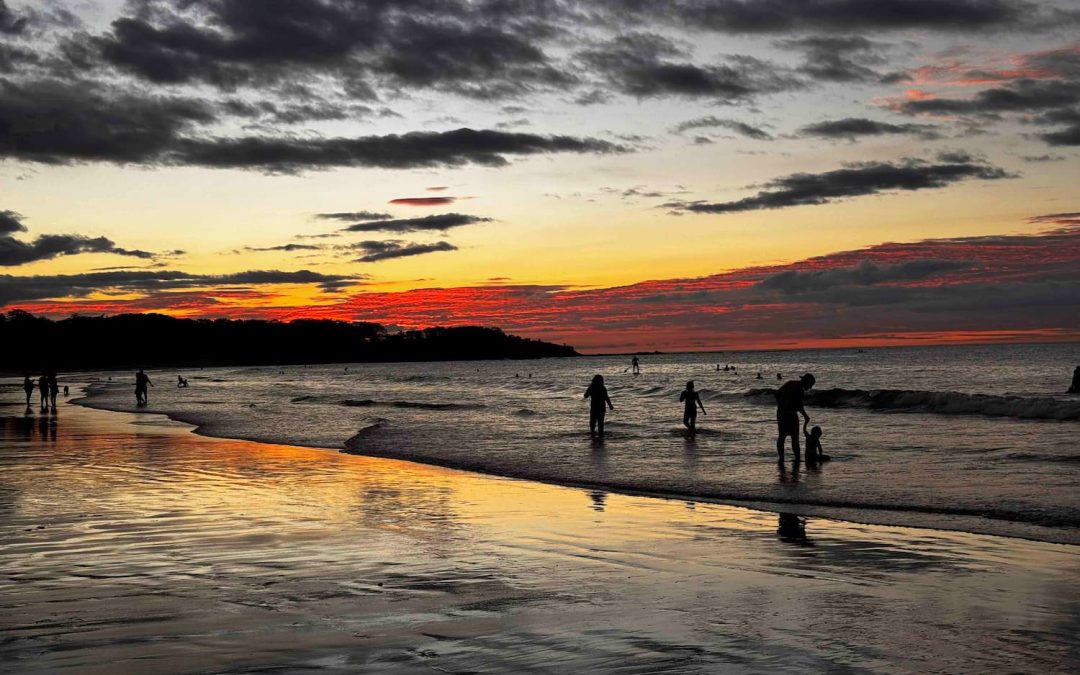This post contains affiliate links.
Looking for a reasonably priced, warm weather alternative to Hawaii? Costa Rica may be your answer. There are many things to do in Costa Rica, and the Guanacaste region in particular, with its beautiful beaches, stunning waterfalls, lush jungle and volcanic region may well be the perfect adventure filled alternative to Hawaii.
I spent a week based in Tamarindo, touring the Guanacaste region, prior to a conference I was speaking at in San Jose the following week. The drive from San Jose to the west coast, with stops in La Fortuna, and La Paz Waterfall Gardens was amazing, but that’s for another post!
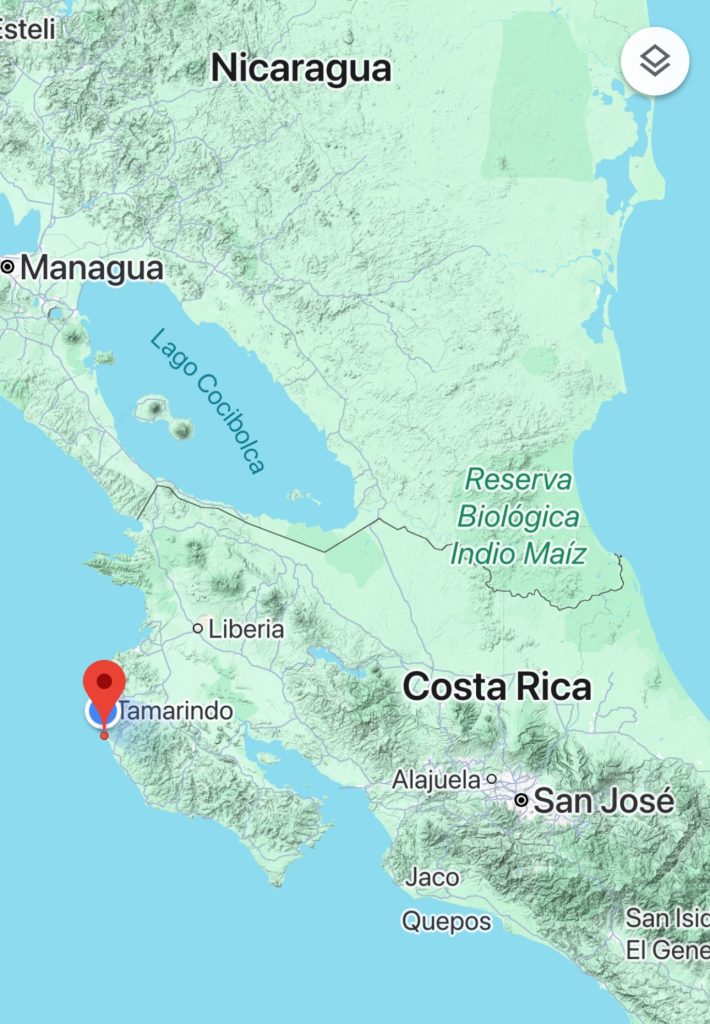
Guanacaste
The Guanacaste region on the western portion of Costa Rica is every bit as beautiful and friendly as Hawaii. No knock on Hawaii, I love the Big Island and have been many times. But as travelers search out affordable ways to stay at destinations longer, or look to make the most of their holiday while aligning their tourism spend with personal values, Costa Rica should definitely be in the consideration set. The country is stable politically and is comparatively safe, which can’t be said for all areas in the Caribbean or Central America. Costa Rica was also an early leader in sustainable tourism.

Weather & seasons
Costa Rica has two primary weather patterns: the dry season (December – April), and the green season (May – November). I love how they’ve branded what is traditionally known as the wet season as the green season. Heavy rains during the green season yield lush and beautiful foliage across the country, plus fewer crowds.
If you can catch Guanacaste in early December, coming out of green season into dry season, conditions are ideal. Prices are still shoulder season, everything is lush a green, and tourists are generally lighter.
Let’s take a tour of the things to do in Costa Rica while in the Guanacaste region. All suggestions here are doable as day trips while based in Tamarindo. But you could also base yourself in one of the smaller communities north of Tamarindo, such as Flamingo or Playa del Coco, mentioned in this article.
Beaches
There are numerous beaches in Guanacaste. All of the beaches noted here are accessible as day trips by car from Tamarindo. Keeping with the Big Island Hawaii parallel theme, think of it like staying in Kona and day tripping in search of the perfect beach up the coast. Except you’ll already be staying at a lovely beach, and instead of driving on roads through fields of black lava from past volcanic eruptions, you’ll experience the similar lushness of Hawaii’s Big Island coast along your drive through the Guanacaste coast.
Tamarindo
Tamarindo is a beach town, and also the hub of tourism in Guanacaste. With a population of 7,000 that attracts its share of tourists, Tamarindo attracts plenty of surfers and beach goers.

It can get busy to be sure, since it’s a hub of where restaurants and hotels fan out, but also hosts many shops and several grocery outlets, making it a good base if you’re staying in the area. Think of Tamarindo as somewhat lost in time compared to the upscale scene and towers of Waikiki in Honolulu.
While densely populated with vacation properties, hotels are generally lower in height, and many of them dating back to when the beach and surf scene emerged in the 80s and early 90s. Both the town and the beach have a laid back surfer vibe feel. Tamarindo went from a small fishing village to a major tourist destination, likely accelerated by the release of the surf film Endless Summer, which featured the town.
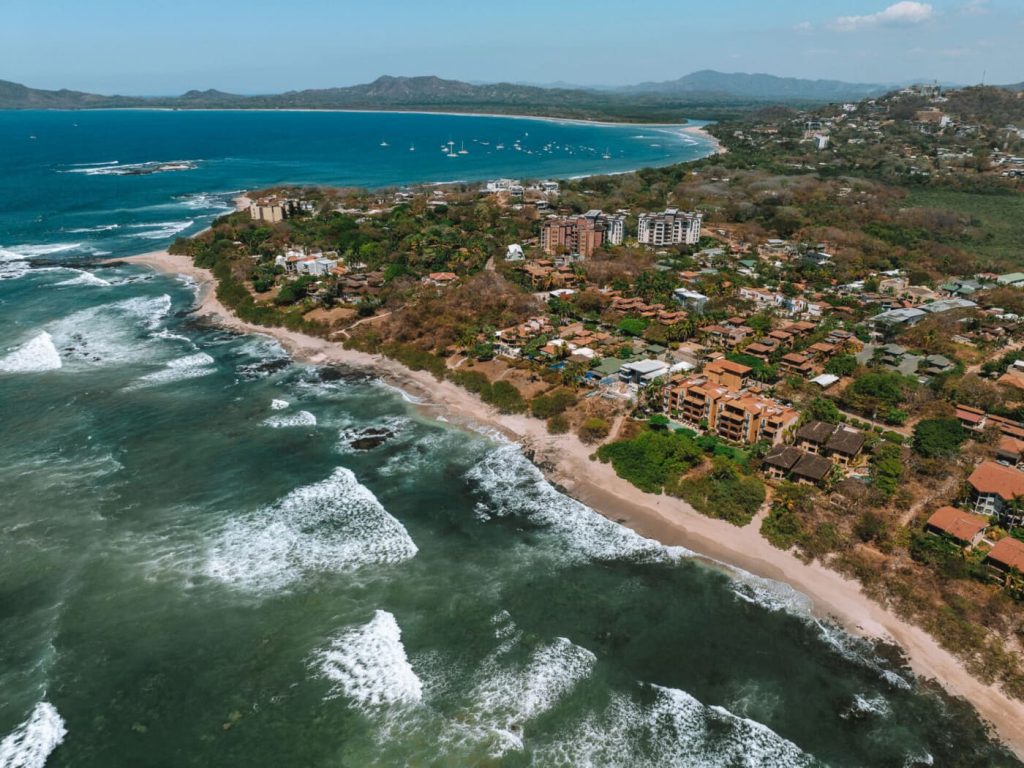
Surfing in Tamarindo
You can of course surf at Tamarindo, and I’d highly recommend you give it a go. Lessons can be had through Surf Culture, a great little surf shop in town, as well as purchased through venders set up on the beach. I arranged for a lesson through Botella de Leche, the hostel I was staying at.
The waves at Tamarindo were a great size for a beginner in early December, and I was able to cruise comfortably on a 10’ long board. There are different areas of the beach, suitable for various levels. Tamarindo is a sand break, meaning the bottom is sandy and forgiving, rather than a rocky break.
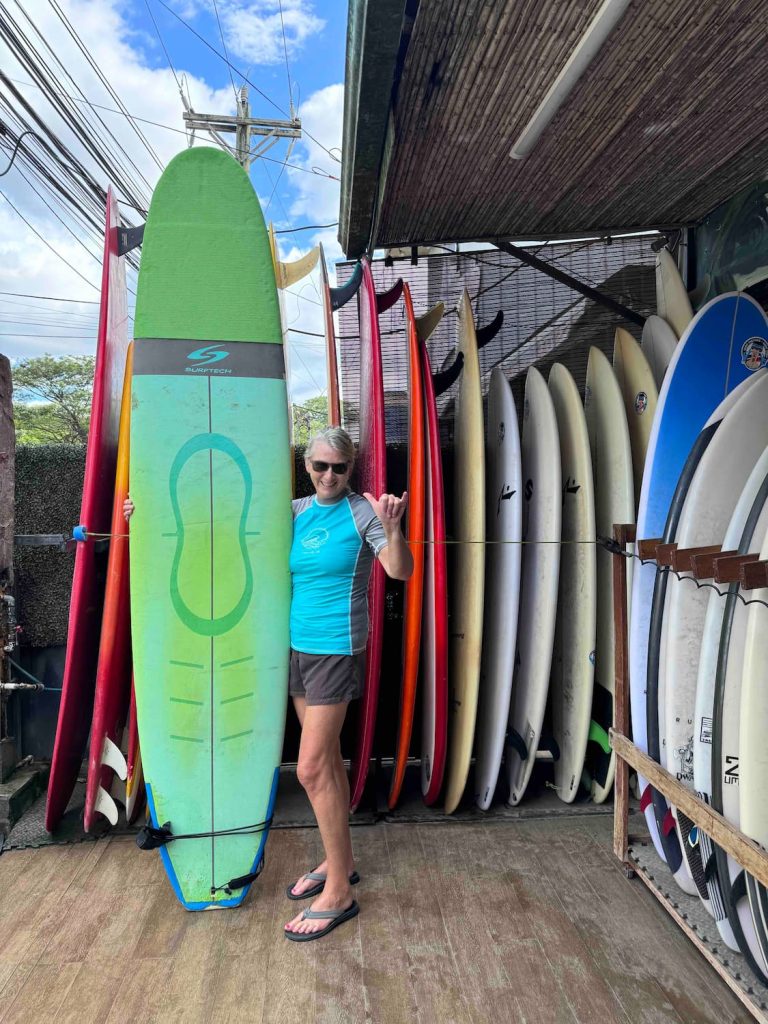
I returned to Surf Culture and second day to rent a 9’ long board one other afternoon. Be sure to ask where you’re staying about lesson or rental discounts. Botella de Leche had a discount arrangement with Surf Culture, and I was told several other accommodations have surf lesson and rental arrangements for their guests.
Walking & swimming at Tamarindo beach
Besides surfing, Tamarindo is a great beach to just walk – endlessly. The beach is huge, and because it has such a gentle rise, the hard packed sand at a lower tide makes walking for miles easy. Be sure to walk the beach at sunset if you are staying close by. Each evening brings a new unforgettable pallet of colors.

Sunning and swimming are of course the main activities on Tamarindo. In the evenings expect lots of people walking the beach as access to Tamarindo’s many restaurants are set up right on the beach.
Playa Blanca
Of the Guanacaste beaches that remain off the radar, Playa Blanca was my favorite. The untouched beach has nearly white sand, tide pools perfect for snorkeling and swimming, and low lying trees by the shore that create shade and cozy nooks. It receives few visitors due to the bumpy pot hole ridden access road. The key is to use the access road from the south, rather than the north from Playa Negro.
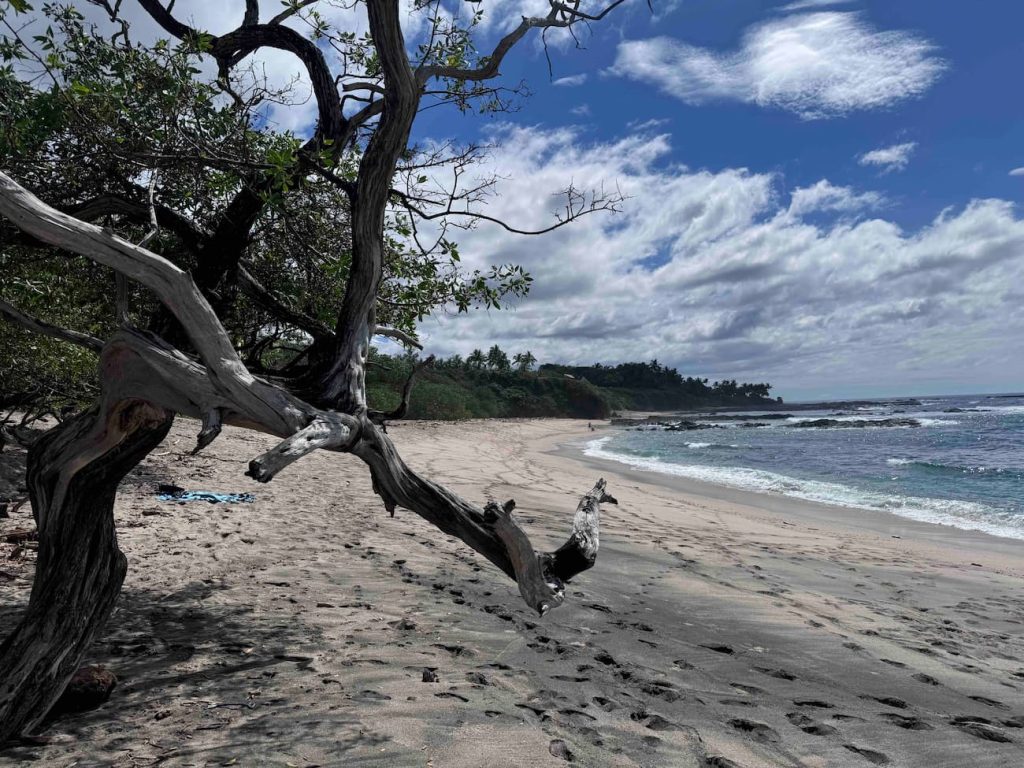
I arrived at Playa Blanca by 9am, perhaps a little keen, but even during the 9-12:30 time I stayed there in early December there were only a handful of people who set up. Playa Blanca reminded me of Makalawena Beach in Kekaha State Park, Big Island Hawaii.

The light aqua blue water, rocky shore break for waves, and gentle tide pools to frolic in. Play Blanca is best at low tide though, to ensure lots of beach. Although high tide would still offer fringe white sand, it was definitely more expansive at low tide.
Getting to Playa Blanca
I followed the Waze navigation map which lead me to an access road above the beach. It was a bit rough, but my rental 4×4 Jeep was up to it.
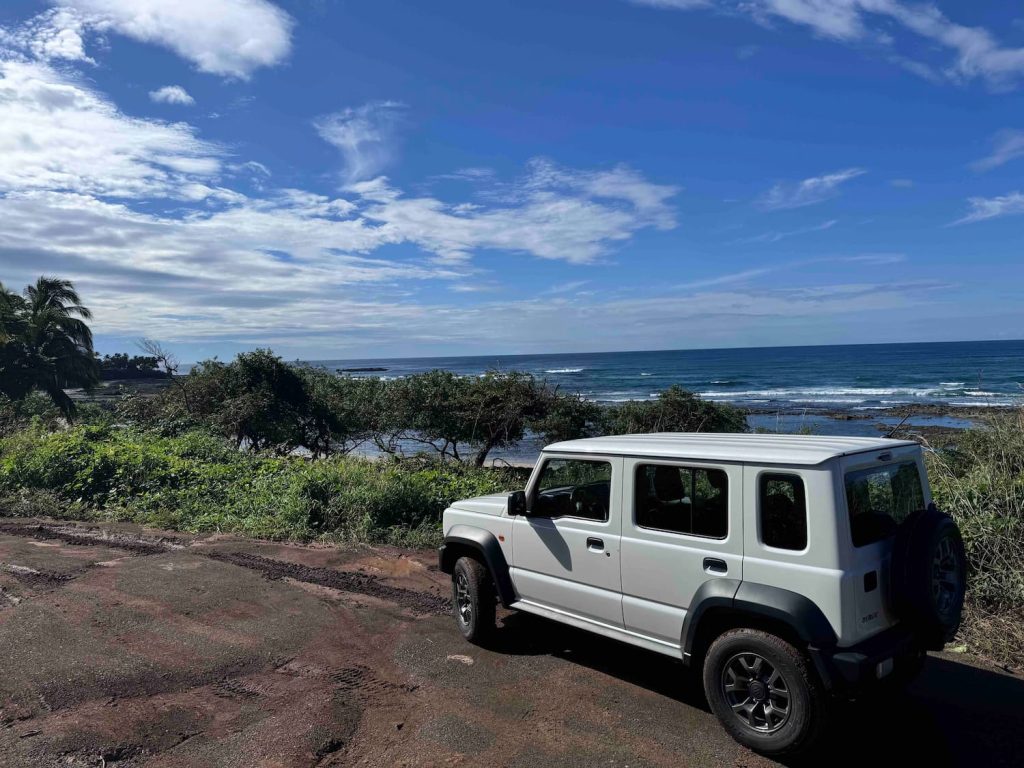
Later, once walking to the far end of the beach, I discovered a car park area, managed by a fellow charging 5000 Costa Rican Colon, or $10USD for the day. To be honest this would have been an easier place to leave my car, since where I parked was extremely limited for space, and a bit sketchy without a 4×4. So I’d definitely recommend this route for safety and convenience. In theory, the parking fee also includes having someone watching your car for the day, which is reassuring. (rates applied 8am-6pm)

Playa NegrA
While Playa Blanca is known for its white sandy beach, Play Negra sand is black. Just like Hawaii, Costa Rica has back sand beaches too, and Playa Nego is one of the nicest.
This beach is 30 minutes south of Tamarindo. It tends to be a very quiet beach not frequented by tourists, but that’s likely because of the rough unpaved road with endless pot holes, to access it.
Playa Negro is known for its world class, consistent surf waves, and especially popular amongst more advanced surfers, but there are some smaller breaks suitable for beginners.
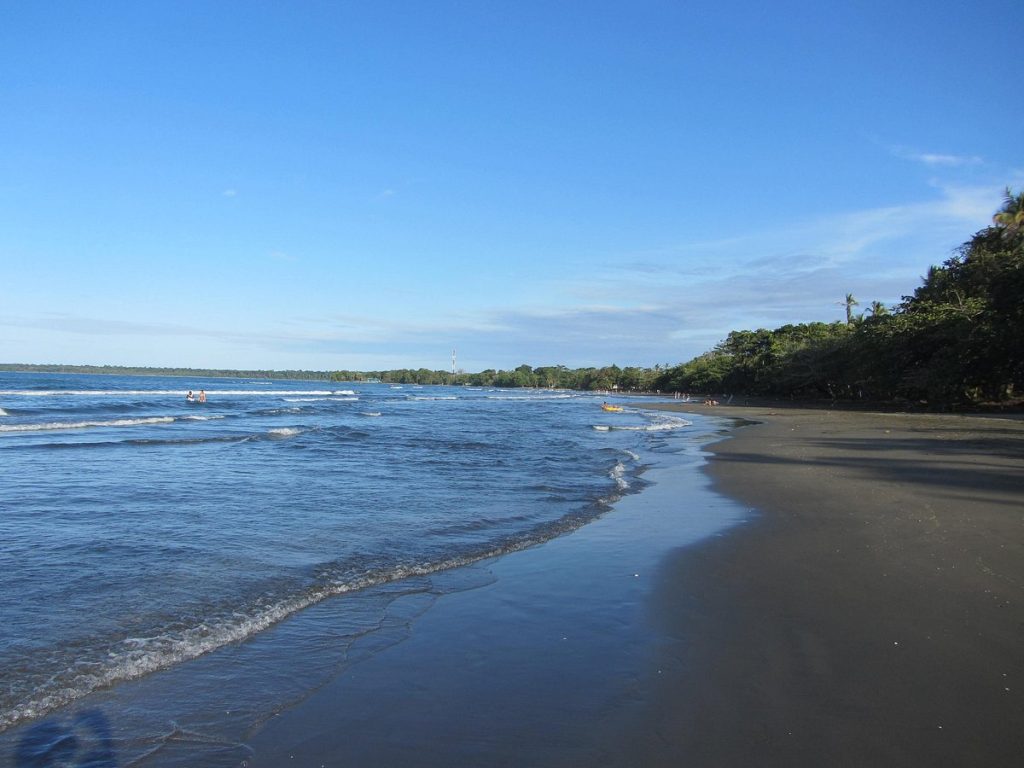
Playa Negro is located in the small community of Los Pargos, known for its rustic charm. Los Pargos is also a growing area for wellness retreats, so if you’re in to yoga, you’ll find options here.
The 3-beach tour day
I do love a good beach, and searching them out in the Guanacaste region became a bit like sport. So one day I set out to tour three different beaches in a single day, with the intent to then return to my favorite.
These three beaches, Playa Flamingo, Play Conchal, and Playa Purto Viejo could be combined into one big happy beach tour day.
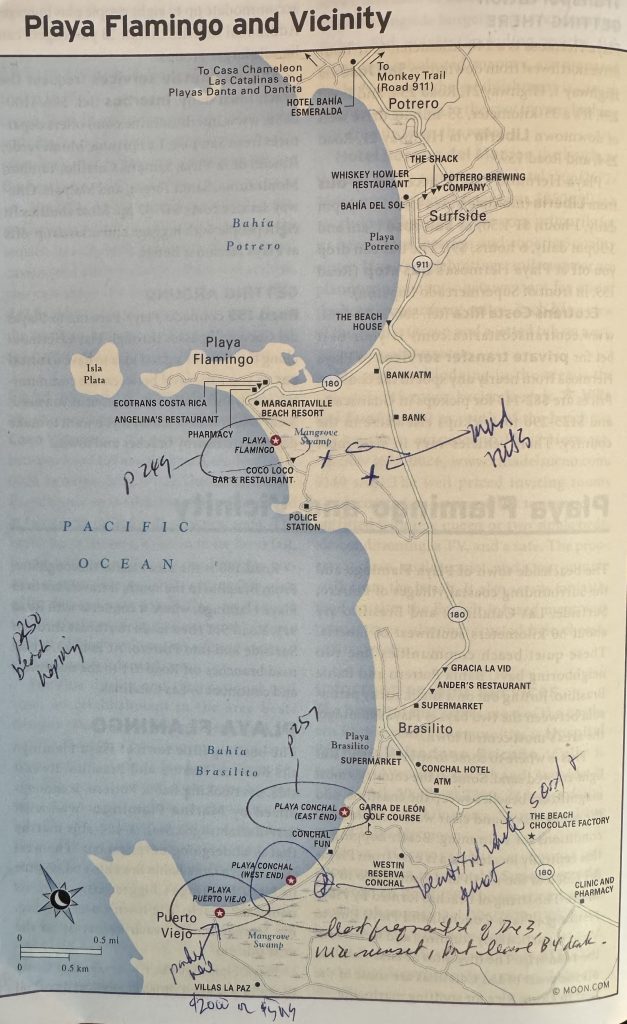
Playa Flamingo
Playa Flamingo is one of the more popular beaches on Costa Rica’s west coast, so don’t count on having it to yourself. That said, the beach is peaceful, but offers a lively atmosphere, and plenty of restaurants and bars in the town of Flamingo.
The area has a couple all-inclusive resorts, and lots of condo rentals, and could be a good alternative base to Tamarindo. Playa Flamingo beach is within a sheltered bay, protecting it from larger ocean swells, making it popular for swimming.

I have to chuckle every time I reflect on my initial drive to Playa Flamingo though. Let’s just say, don’t take the route I took!
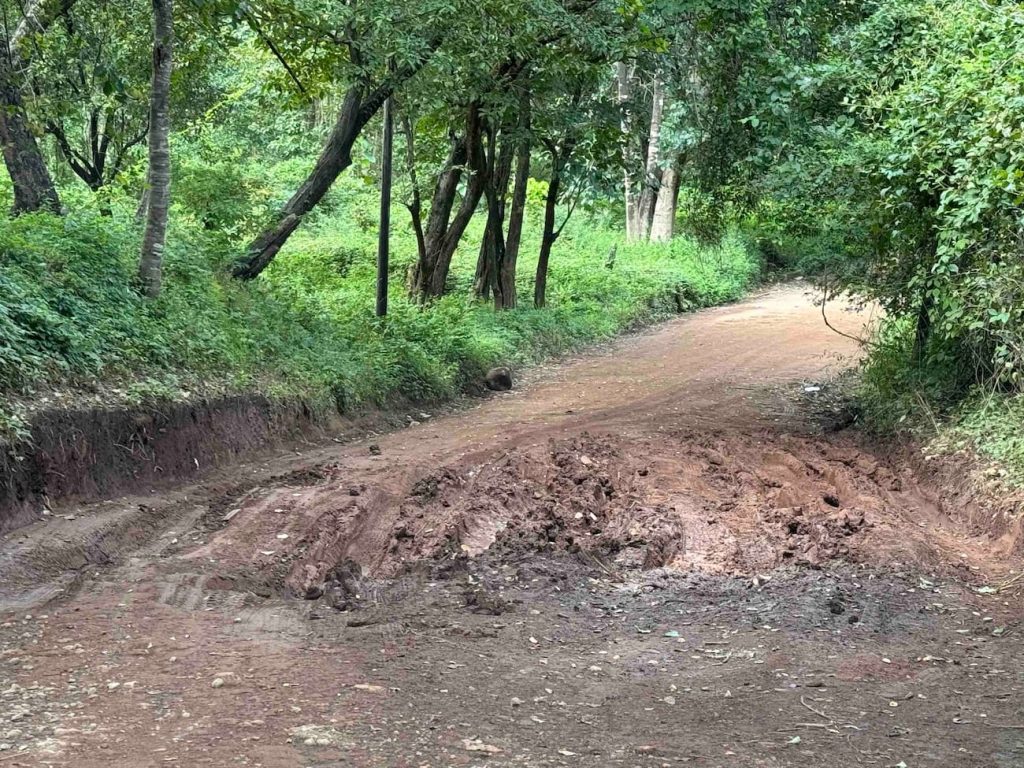
After thinking I might well be mired in mud forever, having stopped at yet another potentially impassable spot on the dirt road in, I trekked on with encouragement from a local who was walking by. Once I emerged to the beach area and saw countless other vehicles, I through to myself, “There’s no way all these cars drove through that.” Indeed they did not. There was a perfectly good and well paved road through town.
But my Google map had made an alternative suggestion – to save me time apparently! Lesson learned. Be sure to check for paved routes as an option when navigating in Costa Rica, and use the Waze app, with marked local hazards!
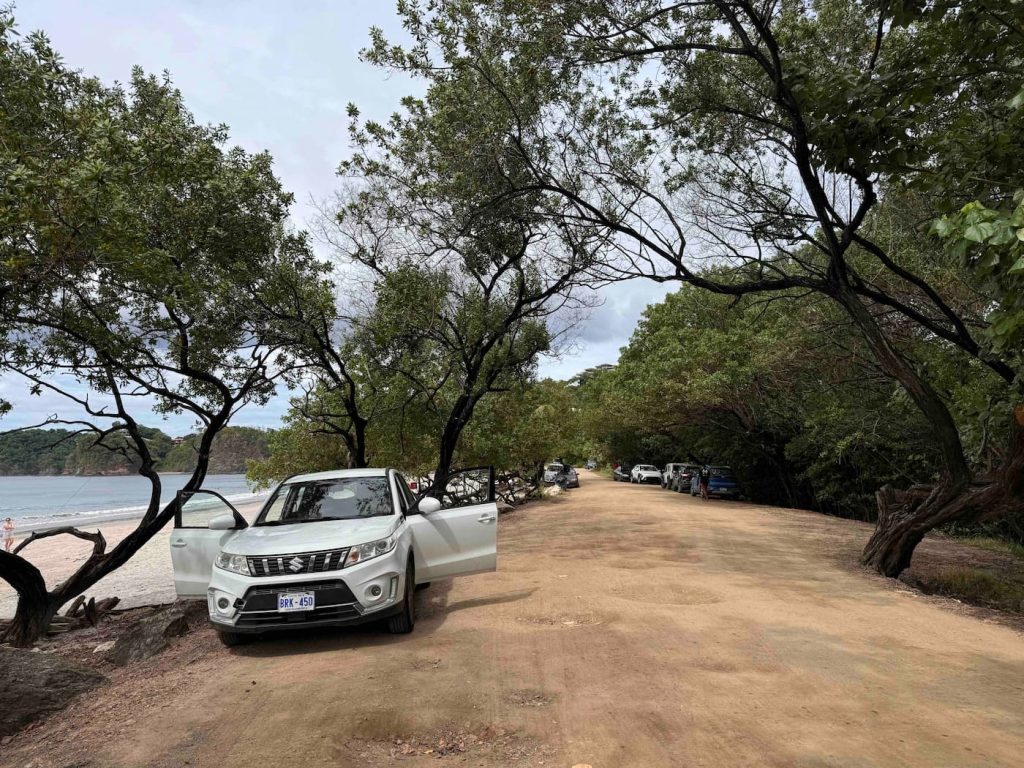
There were several vendors set up offering massages at Playa Flamingo. After speaking to an American couple, they assured me it was amazing, and very professional. Costs were $40 for an hour, but $20 for a half hour is negotiable. Highly recommended!

Playa Conchal
Playa Conchal is just south of Playa Flamingo. This beach is famous for its glittering white shore, made from crushed shells, rather than sand. The water is an amazing turquoise blue, making it one of the most beautiful beaches in Costa Rica.

If you access the beach from the small community of Brasilito, it’s a short walk to the beach. But this also means this area of the beach is busier. Instead, I parked in the access area for Playa Purto Viejo, and walked up to the western end of Playa Conchal.
The west side of Playa Conchal was totally empty, except for a few people day I visited in early December. I didn’t walk all the way to the east side of the beach, but I could see there were a lot more people towards the Brasilito side.
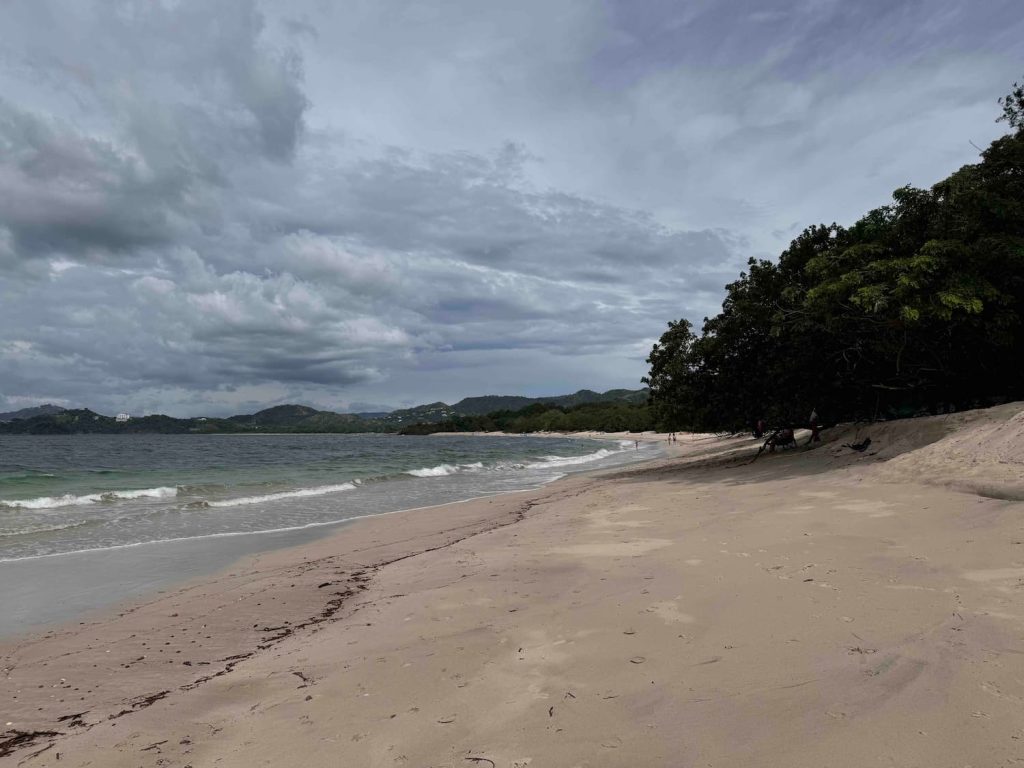
Playa Puerto Viejo

Playa Puerto Viejo is a tranquil beach located near Play Conchal, but it is relatively unknown. The ocean here is a beautiful aqua blue, and the sand has a soft pink tinge to it. The atmosphere is calm, and much less busy than Playa Conchal during peak season apparently. It’s known to be a good beach for swimming, but I did see signs posted with rip tide warnings.

There is a small parking area by the beach. Expect to pay locals 2000 Colon or $5USD for the privilege, but in turn you will get access to a beach that few tourists come to. I was advised that it’s best to depart the area before dark for security though.
Playa del Coco
Playa del Coco, also known simply as “Coco” is one of the most popular beaches in Costa Rica. If you’re looking for relaxation and tranquility, this is not your place. But if you want action – think water sports like diving, SUP, fishing or surfing nearby, plus nightlife, it is worth checking out.
Playa del Coco is also a popular expat destination in Costa Rica. While I did not visit this beach personally, I met others staying there as their base, since the area also offers a lot of condo rentals to choose from. Playa del Coco is also popular due to its proximity to Liberia, a major international airport, being 30 minutes away.
Once you’ve had your fill of beaches, or just crave the lush jungle scene, heading to Ricon de la Vieja National Park is a must.
Ricon de la Vieja National Park
Ricon de la Vieja National Park in the Guanacaste region is less known than La Fortuna, but it also has fewer tourists. Set within 40,000 acres and a dormant volcano, you can spend the day there hiking into the La Congreja waterfall, the Escandidas waterfall, spotting spider monkeys swinging in the tree canopy, and later walking the boiling mud pools and vents, a reminder of the volcanic activity in the area.

While La Fortuna in central Costa Rica, grabs all the limelight, it also has many more tourists, congestion and expense. Ricon de la Vieja offers a similar and very rewarding experience.
This National Park is off the radar for many tourists, seemingly because most who come to the west coast are seeking beaches. But located a little further north and inland within the Guanacaste region, lies the treasure of Ricon de la Vieja.
Getting to Ricon de la Vieja
This park is set within the dormant Cerra Von Seeback volcanoes. At 40,000 acres the park is huge. I accessed the Pailas Sector, 25km north of Liberia. The park is open 8am – 5pm Tuesday – Sunday, with the last entrance at 2:30pm, to allow guest enough time to tour before closing. They don’t want anyone in the park after the sun has set.

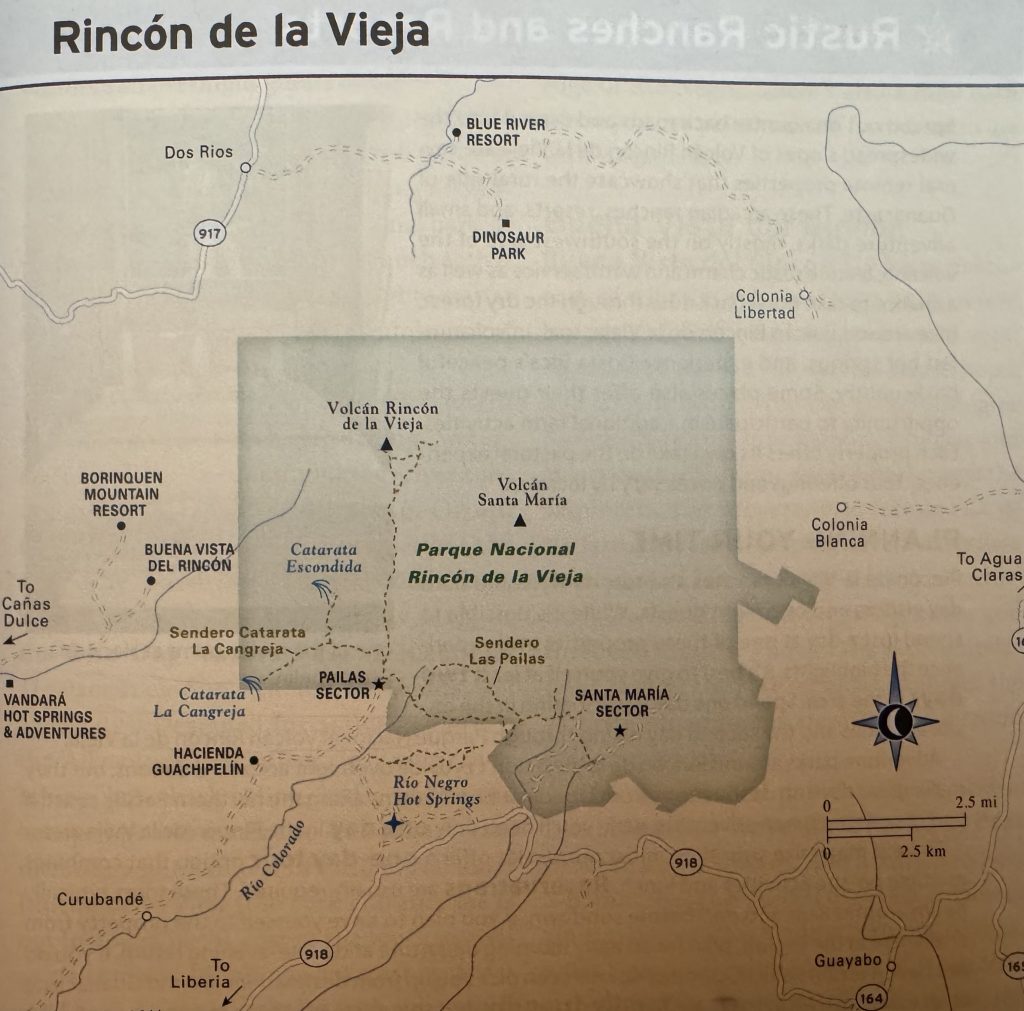
There is a toll of 800 Colon per person at a gate, which crosses over private property, when you drive in. The fee is cash only, so come prepared.

Once inside the National Park, at the visitor center parking lot, you then can enter the trails through the interpretation building. Reservations are required to tour the park. They can be made on the parks website “Area de Conservation Guanacaste”, but you can also do it online once there. The fee was $15 USD to enter.
Waterfalls and hiking
I hiked to the La Congreja waterfall first, which was a 5km trail (10km return), and I also hiked part way to the second waterfall, Escondidas. I got as far as the high lookout over the park, where you could see steam vents and mud pools from the volcano activity far below. Being uncertain that I would have enough time to make it to the second falls, I wanted to be sure to tour the loop trail from the visitors center, to check out the volcanic mud pools.
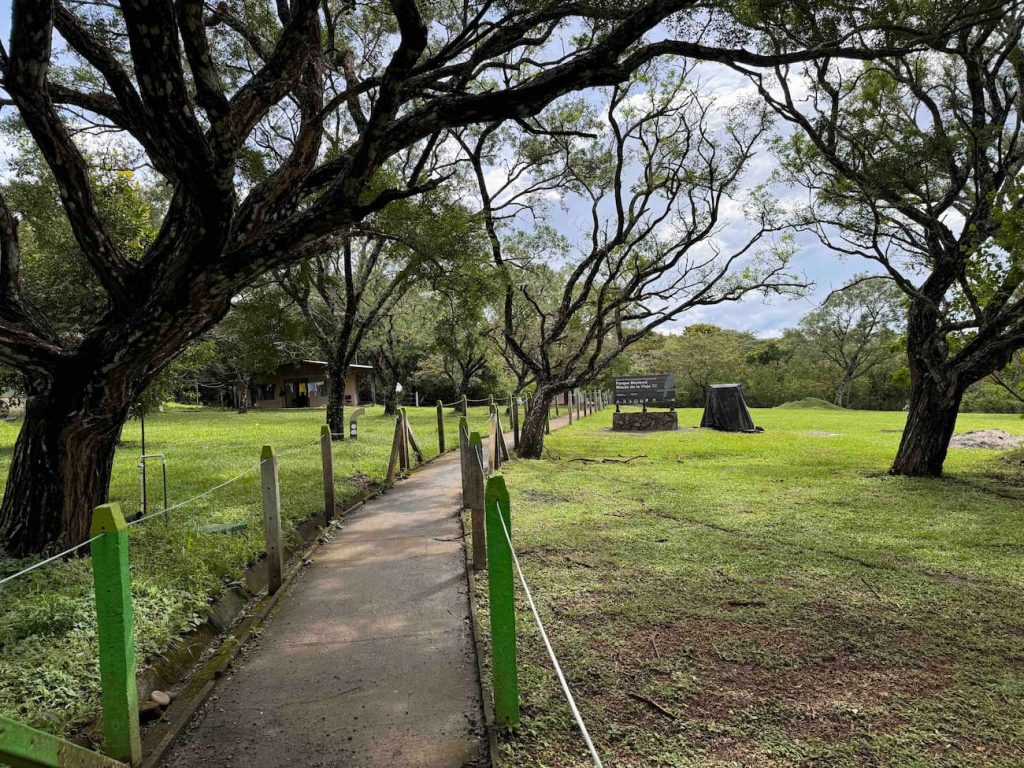
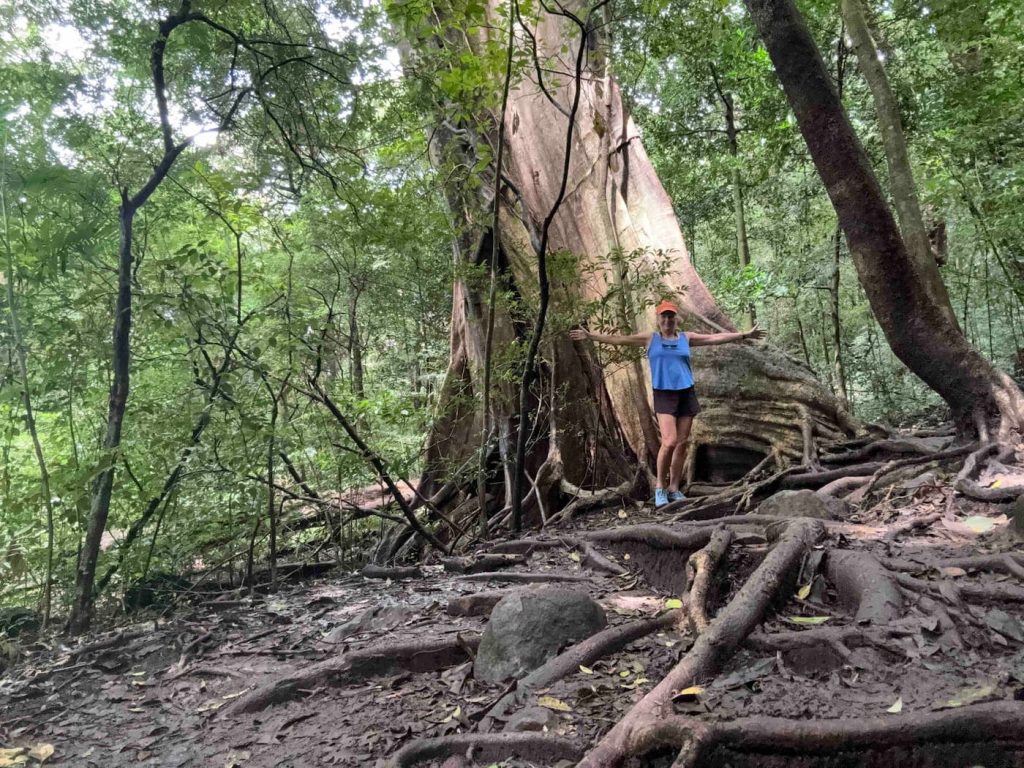
This 3.5km trail along Sadero Las Railes, was primarily flat. It was cool to see the steam vents and bubbling pots of mud. The ever present sulphur smell was reminiscent of visiting the volcano on Hawaii’s Big Island.
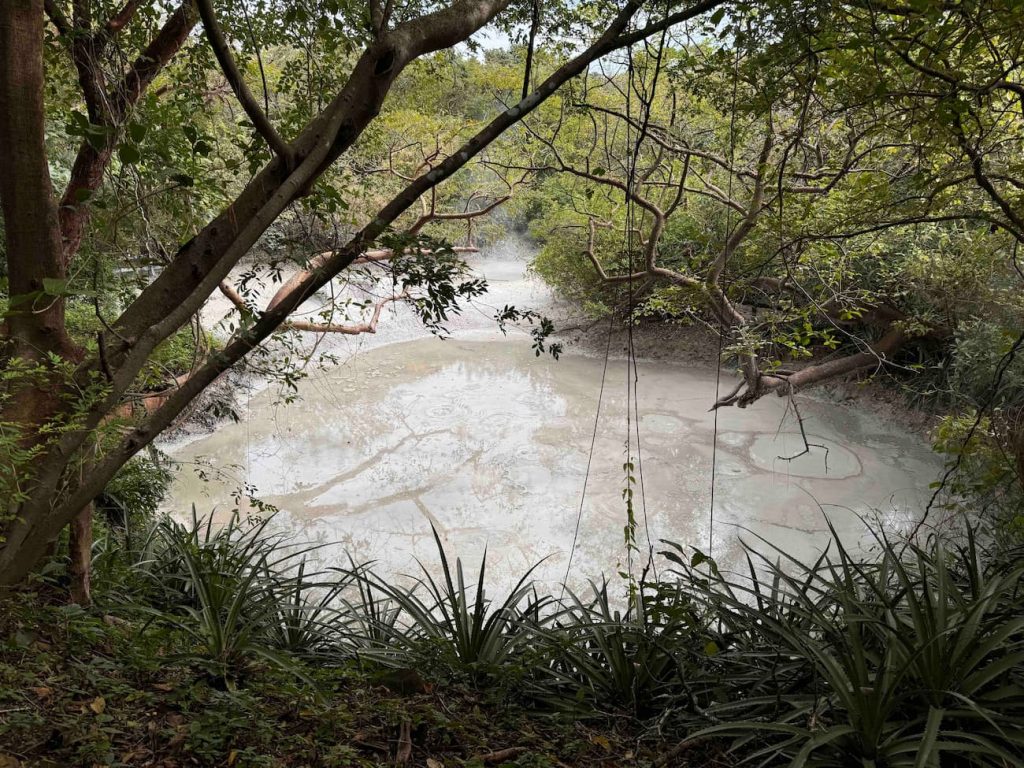
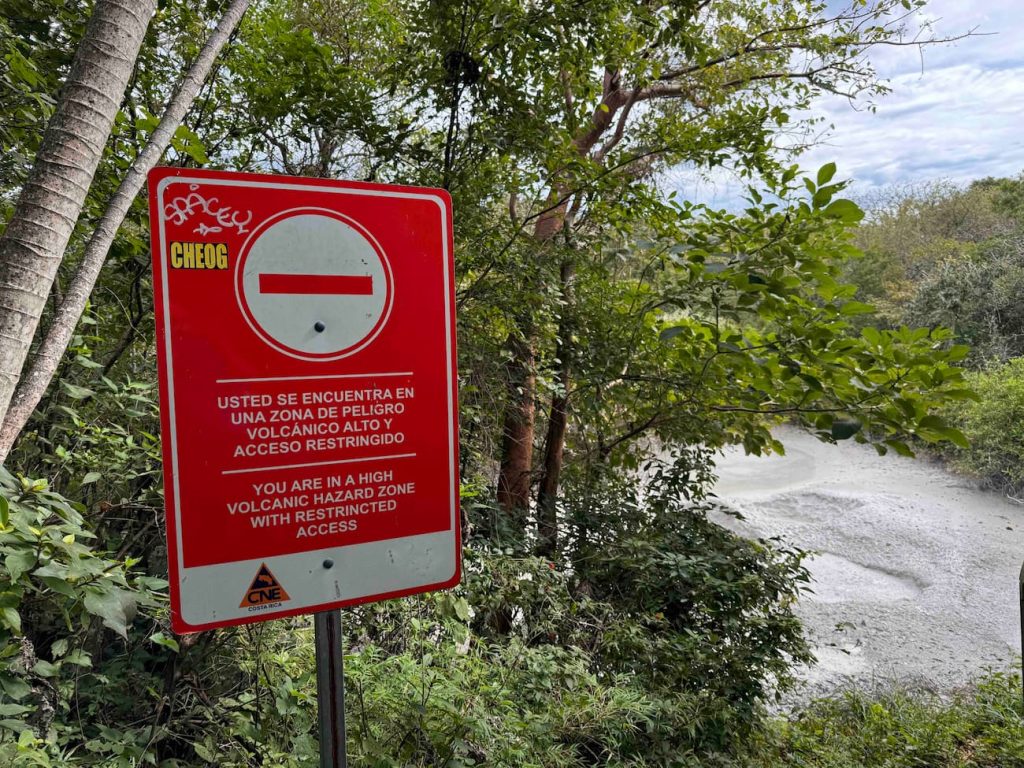
Along the jungle trail I saw several beige spider monkeys swinging and climbing through the top tree canopy. There were also lots of butterflies along the trail, and a chorus of birds and tree frogs. It doesn’t get much more authentic Costa Rica than a jungle experience mixed with volcanoes
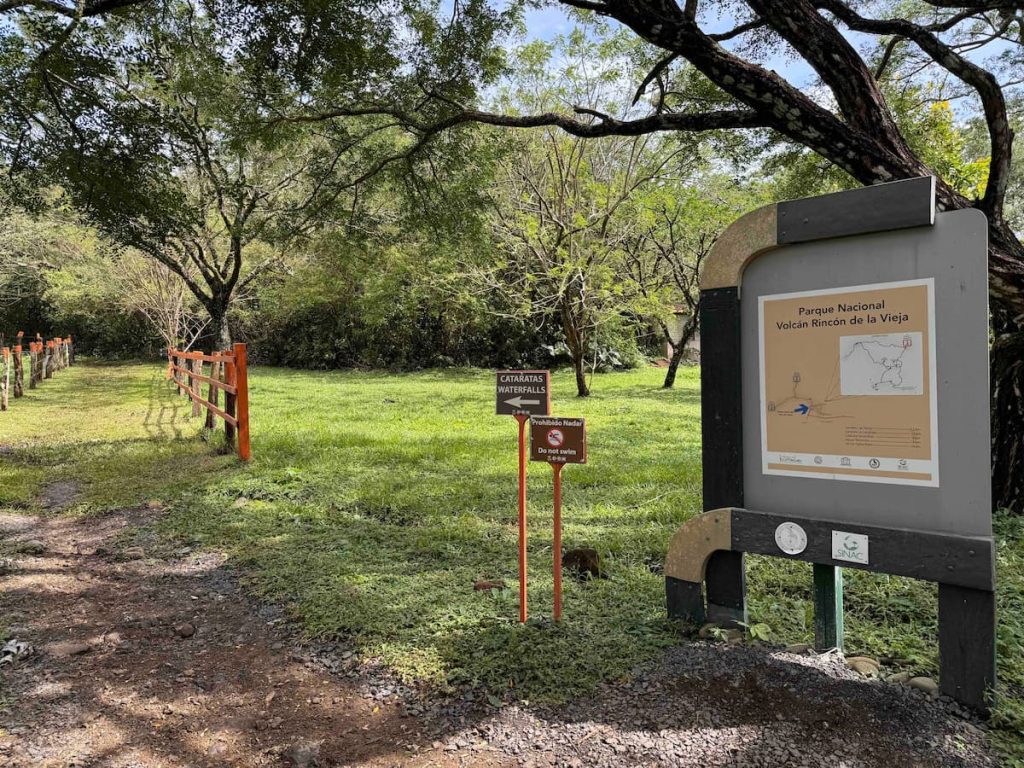
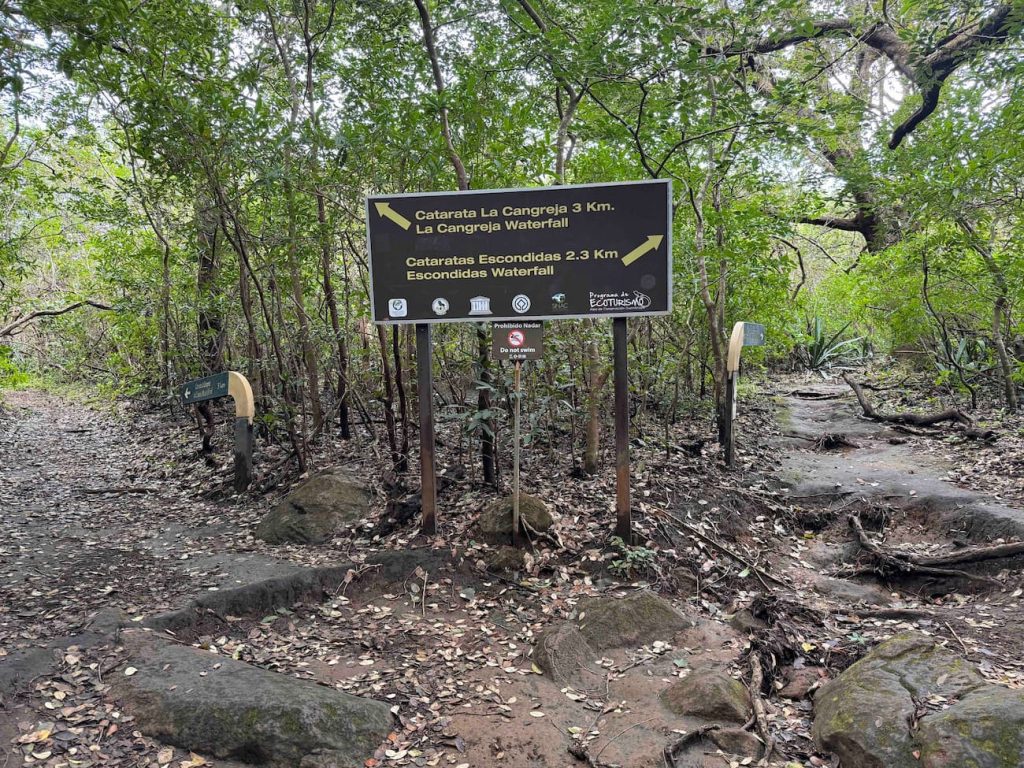
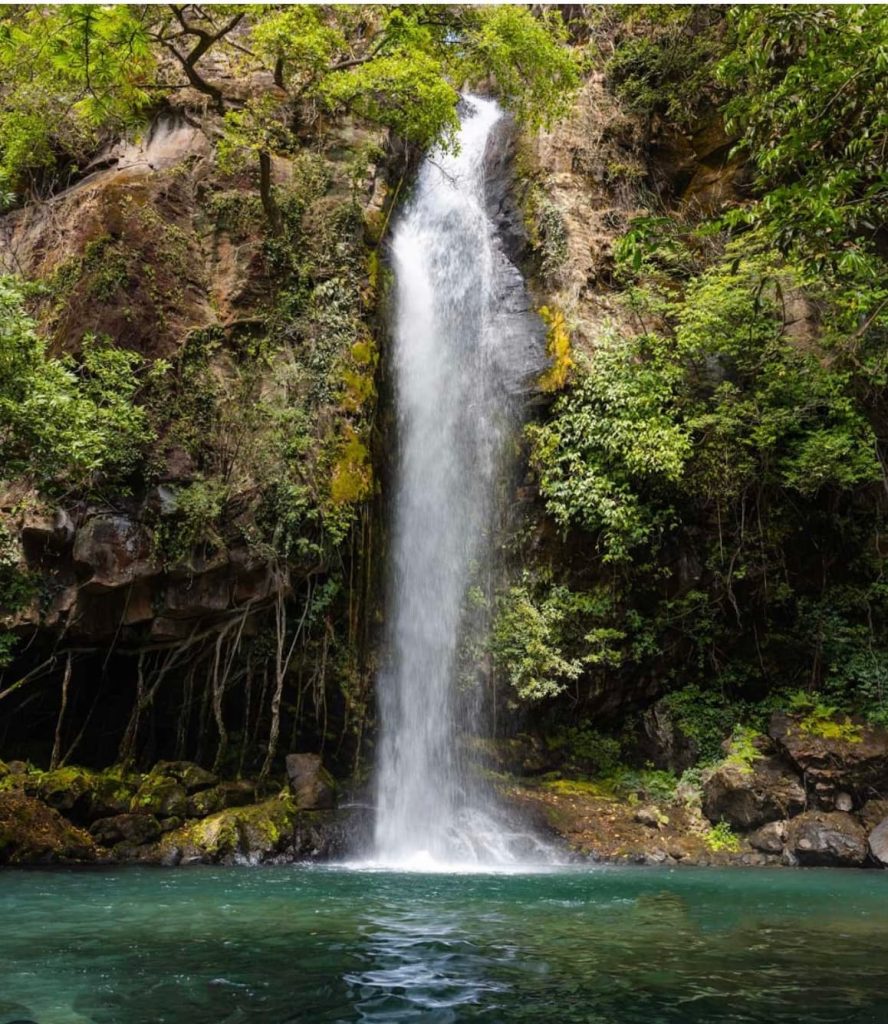
Volcanic steam vents in distance
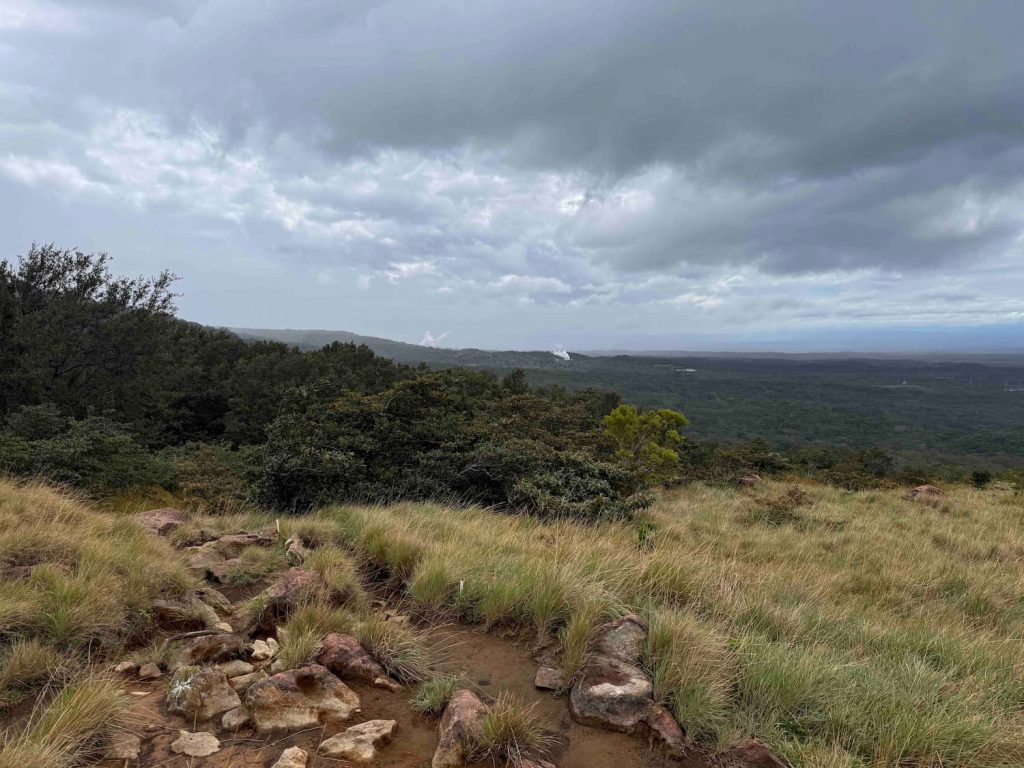
A long day but worth it!
In total the day was 4 hours of hiking, plus 4 hours of driving (2hrs each return from Tamarindo), so it was a long, but doable day from Tamarindo. My goal was to return to my accommodation by sunset.
Traveling solo, there’s caution about driving after dark in case of break down. But to be honest, it’s also a lot easier to navigate unexpected pot holes in daylight. You don’t want to be one flat tire away from disaster in a foreign country with limited Spanish skills!
Accommodation by Ricon de la Vieja
Ricon de la Vieja would be a great area to base for a couple days to enjoy the hiking, as well as wellness spas, or staying at one of the rustic ranches and resorts. There are several in the area, many featuring hot springs and mud baths.
Catarata Lianos del Cortes
Located a half hour out of Liberia, and easily accessed from major Highway 1, it’s amazing that this waterfall isn’t more sought after by travelers. Locals certainly recognize its beauty and easy access, compared to some other waterfall attractions in Costa Rica.
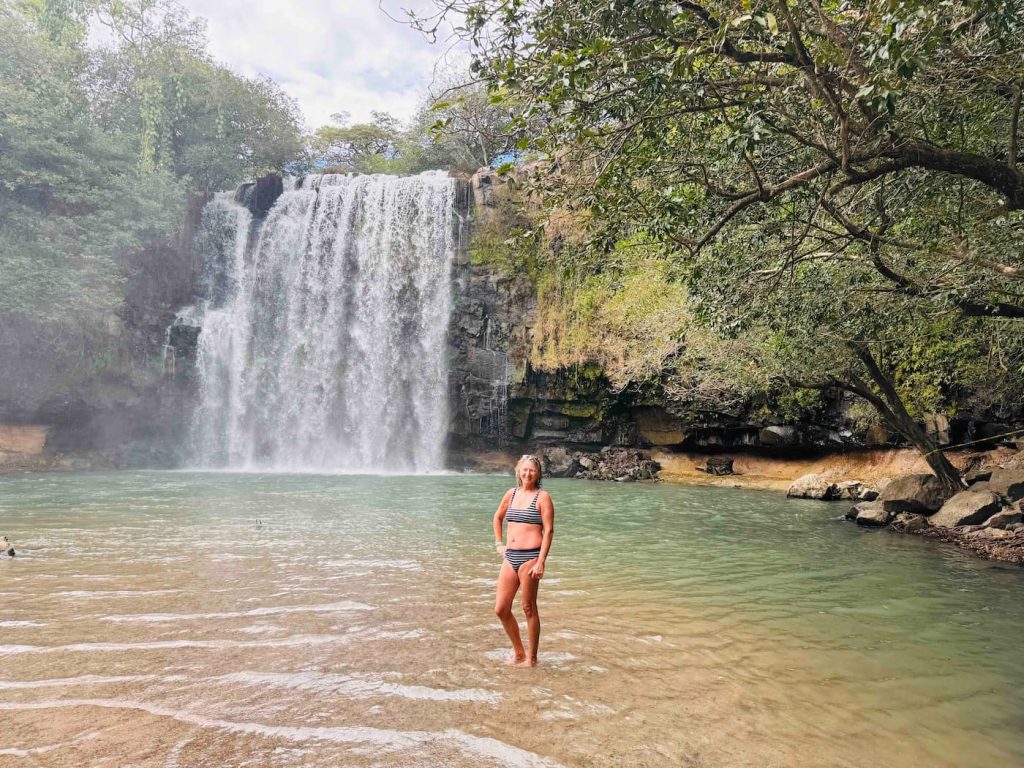
One of the few waterfalls where you can swim
You are actually permitted to swim at the pool base of Catarata Liano del Cortes, something that is prohibited at many other waterfall attractions. Plus you don’t actually need a 4×4 to get there, although the gravel road is bumpy! And you also don’t need to do a major hike to reach the falls. The series of stairs and path is fairly short down to the pools and waterfall, from the parking lot.

Park hours & details
Open 8am-4pm daily, access is $7 USD per person. You can picnic and spread out on the sand below the falls in sun or shade. The falls is a 25 meter cascade that spans much of the rock face – so the power is dispersed across the wall, making swimming below gentle and relatively calm. There’s a lifeguard on duty too. Parking is supervised by a guard, which made it appealing to me, since the day I visited I had checked out of my accommodation in Tamarindo, and had my bags in the car. There are rest rooms, showers and a change room too.
Going behind and above the waterfalls
After lounging by the sand and swimming in the waterfalls, the highlight of my day was meeting some fellow Canadians from Windsor, Ontario. They had chatted up Jose, a local guy, who promised to take them on a hike around the back of the waterfalls to a thermal fed pool, plus climb across the stream at the top for a view over the falls. Did I want to join them, they asked? Of course I said “yes” and off we went exploring!
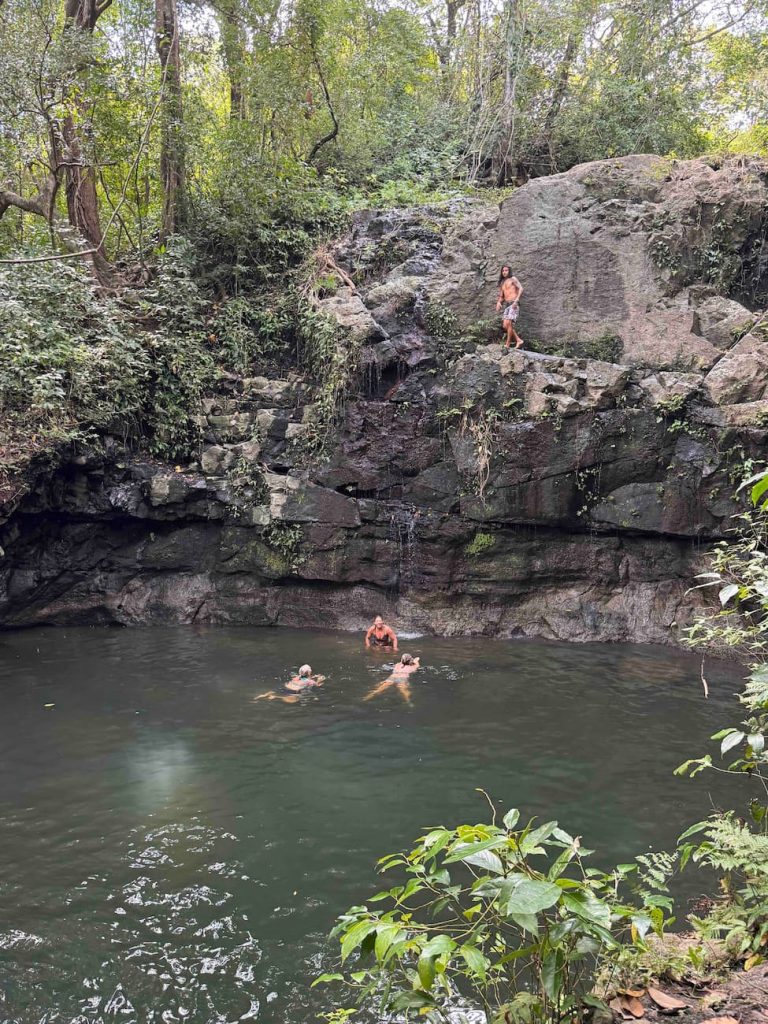
Natural hot springs pool on trail to climb up to top of waterfalls.

Our guide Jose at the top of the waterfalls.

View from the top!
Accessing Catarata Lianos del Cortes waterfalls
The waterfall is best accessed from the northwest. From Liberia, take Hwy 1 southeast for 20km and turn right onto an unnamed gravel road near the pedestrian walkway that crosses over the highway. It’s about 2km from the turn off to the gate, and then a 10 minute drive in to the waterfalls parking area. If arriving from the south, a median prohibits left turns, but there’s a break in the media just north of the pedestrian walkway, where you can turn around and approach from the other direction.

Accessing the Guanacaste coast
The major airport for accessing the Guanacaste region is located in the city of Liberia.
Liberia airport
This airport, while smaller than San Jose, is served by many major international airlines. Most people accessing the Guanacaste region fly into Liberia, or take a hopper flight from San Jose airport to Liberia airport.
San Jose airport
San Jose the major airport for Costa Rica. It is also possible to drive to the coast from San Jose, which is what I did. But you will need a rental car and allow travel time. The drive from San Jose to Liberia is about 4hrs, and an additional 1.5hrs from Liberia out to the coast from there, without stops. If you have the time, and flights are cheaper from your destination to San Jose, this is certainly a beautiful way to experience more of Costa Rica.
Car rental
Renting a car will allow you to explore the Guanacaste region, rather than sit by the pool or your accommodation beach the entire time. If you’re staying in a larger center like Flamingo or Coco, it could be possible to hire a driver for day trips and getting to and from the airport. But honestly, having a car rental available just opens up so many more options!
I rented from Vamos, a local rental agency in Costa Rica. I found them to be reasonably priced, honest about third party insurance up front, and their rental cars included many extras – free local android phone with data for navigation and local calls, and a cooler to keep snacks and drinks cool. Vamos has locations close to both San Jose and Liberia airports, and they will meet you at the arrivals area to complete your rental.

Of course global brands like Budget, Alamo, Enterprise and Avis also operate out of the car rental area of both airports. Be sure to ask them how they handle third party insurance (mandatory in Costa Rica). Many rental agencies will quote insurance outside their car rental fee initially, and then slap on a hefty fee at the counter. Knowing this ahead of time is helpful when comparing prices. Search and compare options here with Expedia car rentals.
Renting and driving in Costa Rica
I’ve written several other articles about renting a car and driving in Costa Rica. Be sure to check out these helpful links!
How to avoid costly Costa Rica Car rental
More Costa Rica Content
Check out this content featuring La Paz Waterfall Gardens in the Central Valley and Highland region of Costa Rica, close to San Jose.
La Paz Waterfall Gardens Costa Rica
One week in Guanacaste region
For an active week in the Guanacaste region, I would suggest basing yourself close to one of the beach areas noted in this article, then spending a few days touring the other beaches, spending a day hiking waterfalls and volcanoes in the Rincon de la Vieja National Park and taking a day at Catarata Lianos del Cortes waterfall. That will provide a great mix of beaches, jungle and volcanoes, plus allow you to sample village life and culture along the Guanacaste coast.
While it is possible to hire a driver, or participate in group day tours, renting a car is highly recommended if you’d like the freedom to chart your own course, while discovering lesser known areas along the way.
Accommodations on the Guanacaste coast
There are a few major village areas to consider for your stay in the Guanacaste region – Tamarindo, Flamingo, or Le Coco Beach, closer to Liberia. Of course there are many smaller hamlets to consider too. Use these maps to orient yourself around options.
Tamarindo
Playa del Coco beach area
Playa Flamingo
Accommodation in Tamarindo
These are our recommendations for accommodation in Tamarindo. Priced from budget, medium range, and luxury, there’s something here for everyone.
Low budget (under $100)
While in Tamarindo, I stayed at Botella de leche. The property is officially a hostel, but in addition to shared dorms, they also have couples’ rooms. That is what I booked. I’ve often stayed at hostels solo and booked a couples room. It’s a bit more expensive that the dorm, but significantly cheaper than other options elsewhere. The room affords privacy and security of items, while the shared cooking and lounge space is a great way to meet other travelers, get tips about the area, and also stretch your travel dollar preparing meals in the shared kitchen.
Botella de leche is just enough away from the main town center to be quiet, while also close enough to walk to the beach and go out to the shops.

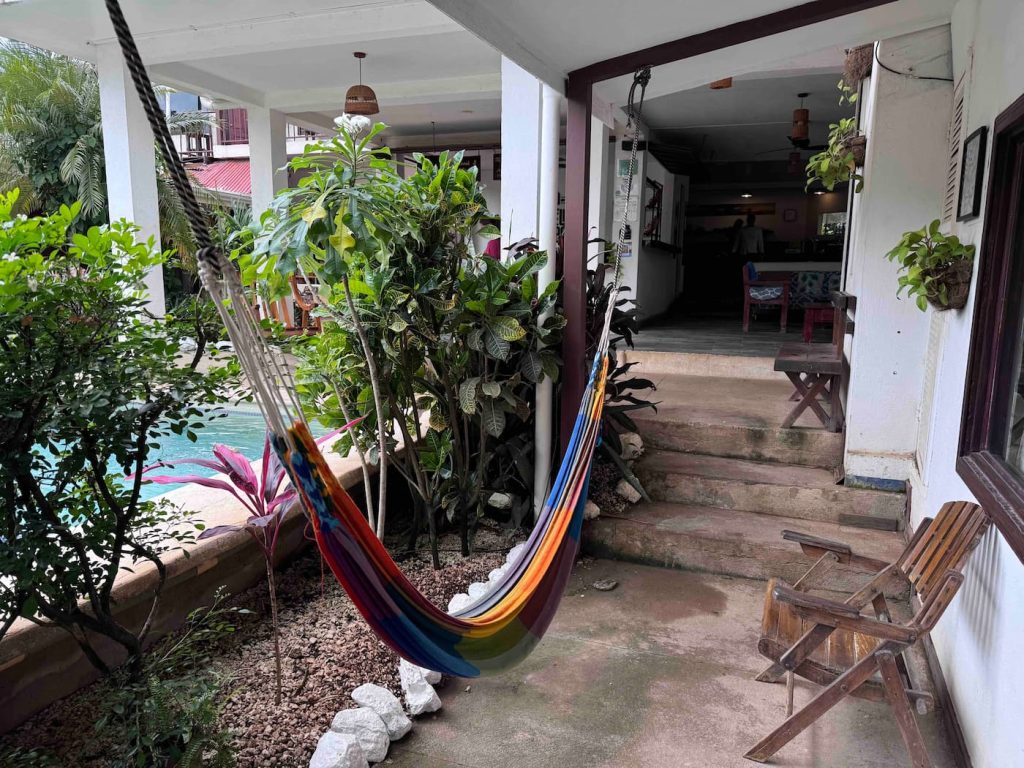
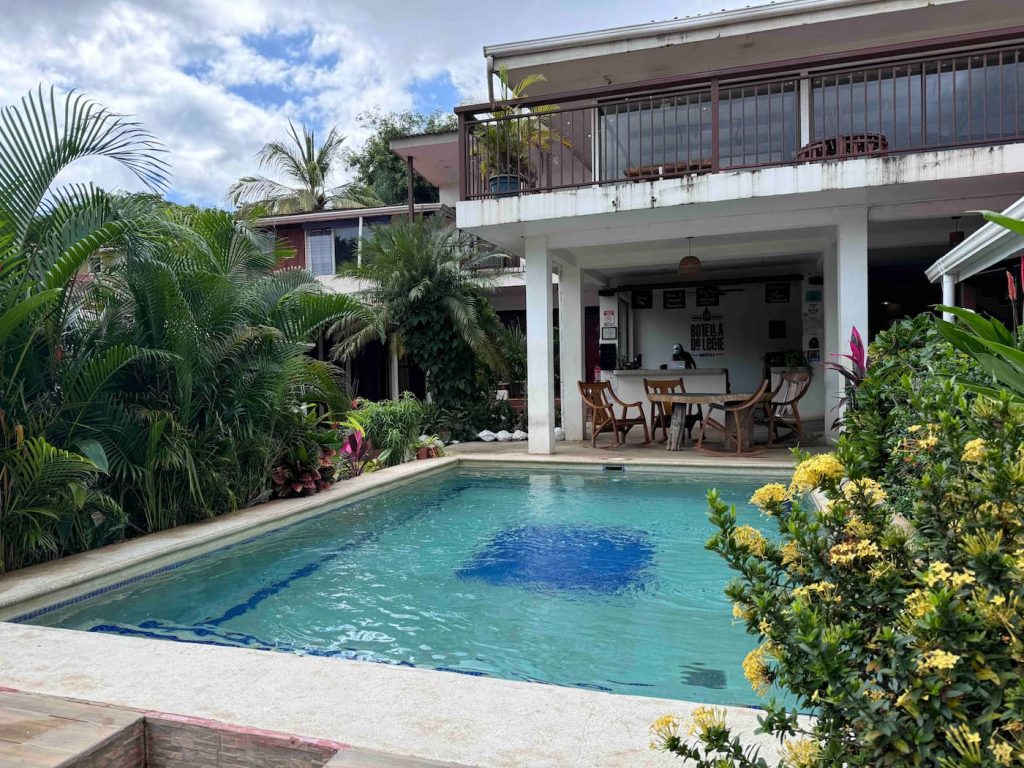
Refugio Surf Lodge is also recommended. Room prices are a little more than couple’s rooms at Botella de Leche, but the whole property offers couples rooms, adults only, with a youthful vibe. That doesn’t mean you need to be young to stay there however!

Medium budget ($150-200)
BOHO Tamarindo. Right on Tamarindo beach, features outdoor pool and patios off all rooms. Continental breakfast included. Highly rated.

Luxury budget ($350+)
Ocho Artisan Bugalows. Located directly on the sands of Tamarindo beach, this property offers a unique, intimate, boutique style stay. Ocho will make you feel like a celebrity!
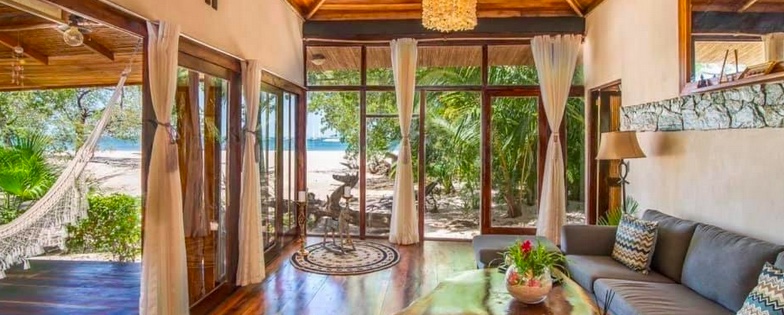
Day trip and other fun activities in Guanacaste
From zipline, to rafting, white water tubing, snorkeling, hiking, safari and general touring, we’ve got your covered for adventure packed day trip activities. Check out a variety of day trips from Tamarindo, and others areas of the Guanacaste region.
- Sloth Sanctuary and Waterfall Adventure
- Zip Line and Rafting Day Adventure
- Blue River Resort and Hot Springs day trip
- White Water Tubing and Hot Springs Day Trip
- Catamaran Boat Cruise with Lunch and Snorkel
- Celeste River and Lianos de Cortez Waterfall Day Tour
- Rincon Vieja Volcano Zipline and Hot Springs Day Tour
- Palo Verte National Park Day Tour
- Yacht charter From Tarmarindo or Flamingo Area
- Canyon de la Vieja 1-Day Adventure Pass
- Private Cruise, Wildlife Safari, and Cultural Ranch
- Rio Celeste Sloth Sanctuary and Waterfall
- From Liberia, Mega Combo Tour with Horseback Riding
- Learn to Surf in Tamarindo

